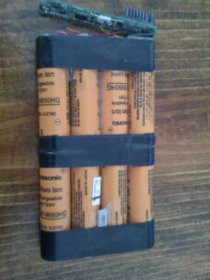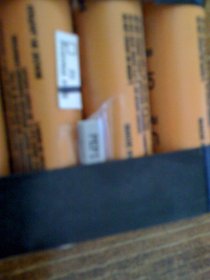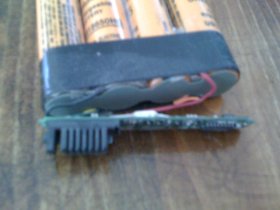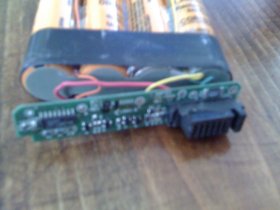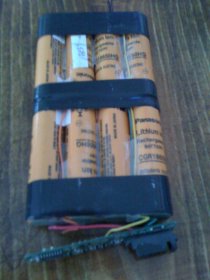Re: how to get longest life from laptop battery
Technical rebuttal – courtesy of last weeks 3 day energy storage symposium and answers from a key player in the SAE Battery standards committee.
interesting information and good points
hard to follow the rebutts though, it would help if you put my text in quotes
you make great points and I suppose your simposium has more current theory then the wiki however a few counter points to your points
taking out the battery affects data security especially since the laptop can easily be disconected from the grid however most desktops do not enjoy off grid power protection and the danger is not that far removed from a desktop, except of course for the grid port on the laptop but that can easily be secured with no added concern over the exact scenario most people have with their desktop
EVERY rechargeable battery charger senses when the battery is full and stops charging.
while it's true a laptop will prevent overcharge on a fully charged battery, this fact is mitigated since (your point), the unit always uses power the battery is always in a state of charge discharge, you want as few charge situations as possible, those re-charge events are not good
now, even if I'm incorrect and there's no "discharge/charge" going on in a fully charged on the grid laptop, never the less a fully charged battery permanently depletes far faster then a partially charged batery and that's the real point
imo there should be a switch so it either charges or discharges for given levels of charge and a user can choose between self regulated or hardware regulated
unless the wiki link is wrong, and I double checked multiple sources and the information is pretty spot on, also look to his foot notes, the battery permanently degrades according to the level of charge, it permanently time degrades more when fully charged then discharged. this is very important to know when developing your charge discharge strategy
once again according to the footnotes you should not store your battery at 100 or 80 percent (your prefernance) but neither should you store it too low, (my previous recomendation, now amended because of your excellant post)
the footnotes and other sources usually recomend 40 percent charge for best life/protection on storage
I suppose my phone batteries last longer then my laptop because my phone batteries are not always being charged, my laptop batteries are
in addition, my phone batteries enjoy a far slower charge, the faster the re-charge the more damage and that might be the main reason
All batteries deplete from discharge.
according to the links, this isn't true as far as practical degradation, while there might be
some degradation on discharge the majority happens on re-charge, this is a significant differance and it's a big one
Battery energy storage capacity degrades based on problems with non-reversible chemistry reactions during charge or discharge
as I pointed out above it's either or, sometimes both but in the li-ion example the marjority of nonreversable chemistry happens on re-charge not discharge, that's a quite significant distinction
there is a reason you need to understand when the battery is degrading, charge/discharge and I give a practical example at the end of this post
Since you can not have discharge without charge assigning degradation to one instead of the other is misleading
the actual facts are more then informative and more then academic they are practical, the actual knowledge of specifically when degradation occurs will help create best charge/use strategy for longest performance on our personal use, that was my very point, you can determine best strategy when you know where the damage is being done the most, how and why
using that knowledge and the knowledge that the battery permanently depletes faster at full charge, then further multiplies that effect when you are re-charging is quite useful
you then take that knowledge and develope the best battery duty cycle strategy for our own persnal lifestyle
Any battery has less to loose if it is not charged so storing partially charged batteries does not buy you anything
of course it buys you something, if you are storing a battery at full charge you are permanently losing 20 percent capacity after a year, that permanent loss is far lower if the battery has a far lower level of charge
let's suppose it loses 20 percent of the charge level, therfore if you have the battery stored at 50 percent capacity it will still permanent capacity at the 20 percent rate but of that 50 percent with the remainging 50 precent left healthy, this is a far smaller loss then 20 percent of 100 percent
the worst degradation to LiIon is from deep discharge cycles. Never let LiIon get below 50% charge, irreversible chemical reactions occur.
this advise doesn't make sense as far as practical application and is probably wrong technically as well (link below the paragraph)
for the practical discussion;
you are on a laptop and you got that laptop for a reason, you use it till you are done and you get as much work done as possible according to your battery status, you don't consider charge level to 50 percent or some made up number you consider when you are going to lose the ability to work and then finish up with headroom
when you are working (or playing for that matter), you get as much done as possible or as much as you feel you have most productivity
in most of my cases, taking laptop that can be used for 2 hours and only using it 1 hour leaves you with a work scenario whence you have just become productive and have to stop, quite counter productive, I use my battery when off the grid for as long as I can to get the most productivity from my time
now for the
technical point from one of the wiki foot notes;
Although lithium-ion is memory-free in terms of performance deterioration
that's important as stand alone but there's more;
batteries with fuel gauges exhibit what engineers refer to as "digital memory". Here is the reason: Short discharges with subsequent recharges do not provide the periodic calibration needed to synchronize the fuel gauge with the battery's state-of-charge. A deliberate full discharge and recharge every 30 charges corrects this problem. Letting the battery run down to the cut-off point in the equipment will do this. If ignored, the fuel gauge will become increasingly less accurate. (Read more in 'Choosing the right battery for portable computing'
he's not being precise, he is saying the fact that the battery experiences permanent degradation the battery self calibration does not know the state of degradation until a full discharge and recharge
this could result in your catastropic scenario where the battery thinks it is not discharged when it is and the battery will go into deep discharge and create more harm then had you discharged the battery for re-calibration
this calibration pretty much has to happen on a regular basis since the battery is always in a state of permanent degradation, (less so with lower charge)
also, something you are not considering is the fact that li-ion is self protected against deep discharge, it self regulates that and the battery becomes unusable till recharge even though there is adaquate charge to run the laptop, that's internal, it even goes so far as to set an internal trigger that prevents any use of the battery if it gets too low and the battery will succesfully be resett with specific tools if you get to it before it's totally depleted, I don't think you lose much at all going to full laptop discharge of a li-ion since it self regulates against deep discharge
more from the link after your quote;
Totally incorrect. LiIon uses a 3.6V cell stacked in series to get higher power for applications like laptops, electric cars, etc. One low voltage cell (MP3 Player, Cell phone (smart phones may stack 2 cells)) acts the same as multiple cells stacked to power a laptop. This urban myth may have originated since stacked cells in LiIon batteries need to have cell charge balancing circuitry
he disagrees;
Eventually, the cell resistance reaches a point where the pack can no longer deliver the stored energy although the battery may still have ample charge. For this reason, an aged battery can be kept longer in applications that draw low current as opposed to a function that demands heavy loads.
however there is a smaller effect depending on the type of li-ion you have;
The lower energy dense manganese-based lithium-ion, also known as spinel, maintains the internal resistance through its life but loses capacity due to chemical decompositions. Spinel is primarily used for power tools.
for those batteries it seems the type of discharge does not affect the duty cycle or ability of the battery to transmit said charge
he goes on with a time vs charge depletion rate and graph;
The speed by which lithium-ion ages is governed by temperature and state-of-charge. Figure 1 illustrates the capacity loss as a function of these two parameters.
which isn't as useful as li-ion technology improves
now about this;
Congratulations. The battery manufactures like people to trash batteries as fast as possible.
excuse me?
that's uncalled for, I use my battery according to my personal workload and pleasure, for my workload I have created a strategy that will get me an extra 6 months to a year of service from a battery
I do not nor care to go your route and use a battery and then stop when it reaches 50 percent charge, not only is this counter productive for battery life, it's counter productive for worklaod efficiency
or are you suggesting I buy two batteries so I can do the work of one battery?
furhter, you are far better off letting the battery discharge (to a certain level) then plug it in when there is a near full charge already on the battery
best thing to do in that case (if you are not concerned about data loss) is as I suggested, take the battery out, turn the laptop on and work from there
I personally have no concerns over data retention on laptops except for the work at hand, plus for me it's the same level of data security as a desktop that doesn't use battery backup
I will always remove the battery when I am on the grid and the battery already has anything more then 50 precent charge (unless I am counting on a full charge later)
ya I can kick out the plug or even disconnect fromt the laptop port inadvertantly but I don't see that much greater a risk of losing power over a desktop and the benefits far out weight the minor added risk of laptop over desktop, especially since data retention isn't a concern on my out of house laptops
on my inhouse laptop I will take further cautions to prevent loss of power but I will certainly be removing the battery for the added life
again, this is because the battery depletes more with a full charge then with a partial charge and that's how I'm going to keep my batteries in wait until I think I'm gonna need a full charge off the grid
perhaps the wiki and his footnotes need to be updated, perhaps I extrapolated where I shouldn't have
in any even, here's how the information can (and should) be used for my own laptop scenario, this scenario is in effect just about every work day by the way, it's not something I made up to suit the conversation
suppose I come to the coffe shop with a depleted battery
I can plug in and then go to work with a full charge however I will plug in at work also
this is going to add permanent full charge time depletion where none need to occur
instead, I am going to plug in with battery out, not charging the near depleted battery
when I get to work I will also not charge the battery, until the end of the day, whence I will plug in and have full charge for off the grid at the restaurant where no grid is available
I have saved time depletion for a full 9 hours, where if I did not consider the fact that the battery depletes on charge and then more becuase of full charge I would have used a completely counter productive strategy
this is the reason we need to know when the battery depletes most, (on re-charge and then time depleted if it has full charge)
in the end, batteries improve with ongoing research and these web sites I used for referance could be obsolete and I recognize the fact that a web site makes a claim doesn't mean it's accurate information


